WHETHER YOU’RE BOONDOCKING in a national forest or staying at a remote campground, weak cell reception makes it difficult to work, stream, and stay in touch with loved ones. The best cell signal booster for RVs makes a real difference.
These devices amplify existing cell signals, allowing you to enjoy more reliable service even in rural areas with limited coverage. For any RV campers who don’t want to be limited to developed areas, investing in the right RV cell signal booster helps ensure you don’t lose connection when you need it most.
Key Takeaways
- A cell signal booster improves weak reception by amplifying existing signals, helping RVers stay connected in remote areas. This is ideal for work, streaming, and emergencies during off-grid camping.
- To boost a signal effectively, find the strongest starting signal, install a high-quality booster properly, and minimize obstructions like trees or hills for the best reception.
- Top RV cell boosters—like models from KING, Winegard, and weBoost—offer 32x amplification, multi-device support, and compatibility with all major US carriers. They also have options for both portable and permanent installations.
Table of Contents
ToggleHow To Boost Cell Signal in an RV
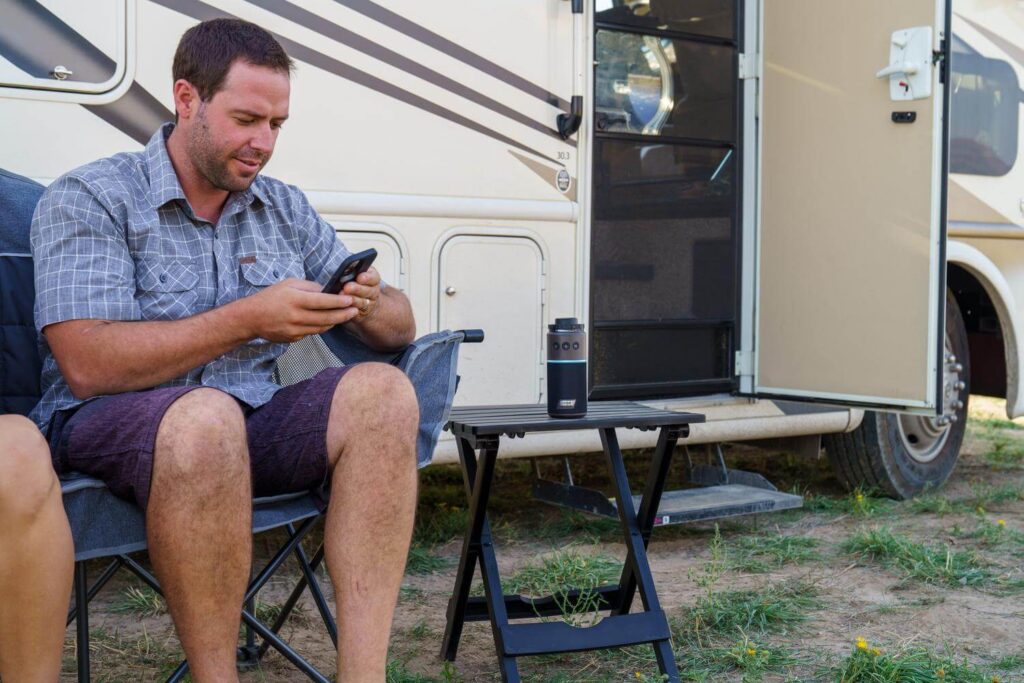
Improving your RV’s cellular reception requires a strategy, even with the right gear. Here’s how RV owners can optimize signal strength when camping in low-coverage areas.
1. Find the Strongest Starting Signal
Cell signal boosters can’t create a signal where none exists. They work best when there’s at least a faint signal to amplify—typically one bar or more. Before choosing a spot to level your camper and set the stabilizing jacks, use a signal strength app to locate the strongest signal in the area. For example, the makers of the weBoost cell signal booster have a dedicated app to help you find the best starting signal. You may need to walk a bit, climb your RV ladder, or use a tripod-mounted antenna to gain elevation and identify the best placement.
2. Use a High-Quality Booster with Proper Installation
A properly installed RV cell signal booster can significantly improve your ability to make calls, send texts, and use mobile data. These systems typically include an outside antenna to collect the signal, a booster to amplify it, and an inside antenna to redistribute it within your RV. Mounting the exterior antenna as high as possible—on your RV ladder, roof, or a nearby pole—gives you the best shot at capturing and boosting weak signals.
3. Minimize Interference and Obstructions
The fewer barriers between your booster’s outside antenna and the nearest cell tower, the better. Dense forests, mountains, and even your RV’s walls can interfere with reception. Try to park with a clear line of sight to open sky, away from tall trees or structures when possible. Use the flexibility of portable or tripod-mounted wireless boosters to fine-tune your setup.
Picks for the Best Cell Phone Signal Booster for Camping
These cell signal boosters for camping work with most providers to deliver better service for your next off-grid RV trip.
KING KX2000 Extend Pro Cell Signal Booster
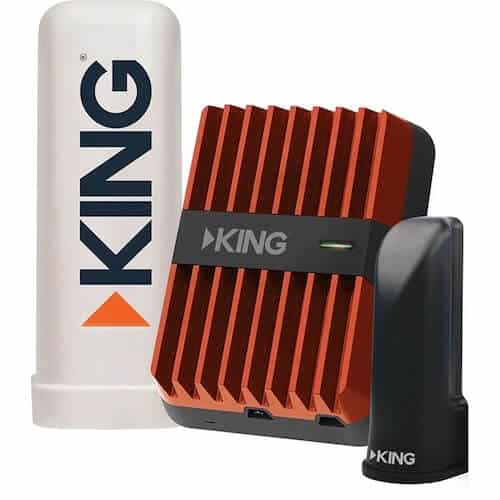
Includes: Booster, Outside Antenna, Inside Antenna, 20’ Cable, Mounting Bracket, Ladder/Pole Mounting Hardware, AC/DC Power Supply, and Instruction Manual
The KING KX2000 is KING’s most powerful signal booster and can reach cell towers up to 74% farther away than other models. It also provides up to 32x signal amplification and works with all US cellphone carriers.
It works with AC or DC power and can mount to your RV’s roof or ladder. It can also simultaneously support multiple devices without additional contracts or monthly fees.
KING KX3000 Extend Go Cell Signal Booster
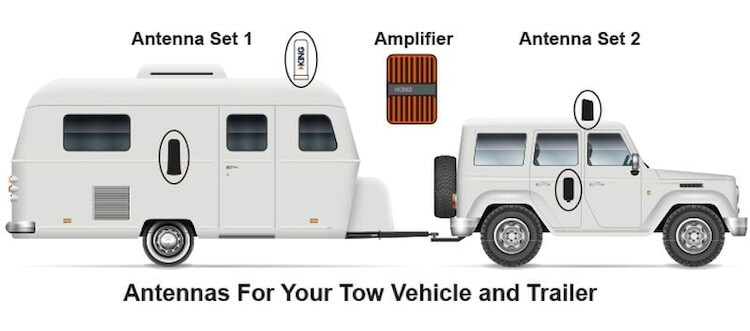
Includes: Booster, Outside Antenna, Inside Antenna, Foldable Tripod, 20’ Cable, AC/DC Power Supply, Carry Bag, and Instruction Manual
The KING KX3000 Extend Go offers the same 32x amplification and signal acquisition capabilities as the Extend Pro. This model also provides a portable tripod for easier setup and the ability to quickly relocate the booster until it acquires the best signal possible for your campsite.
As its name suggests, it’s designed for on-the-go RVers and comes with a carry bag for safer, organized transport. It simultaneously supports multiple users and doesn’t require additional fees or service contracts.
Winegard RangePro Cell Signal Booster
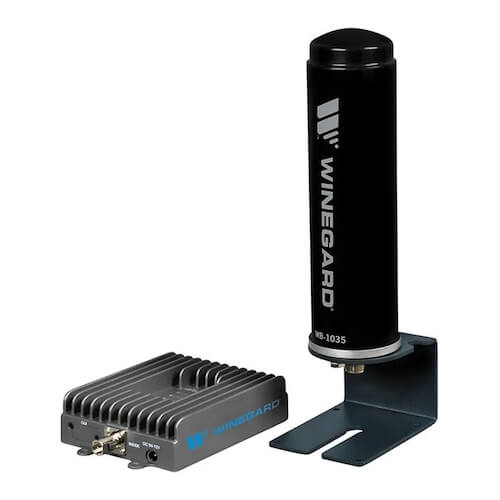
Includes: Booster, Outside Antenna, Inside Antenna, 40’ Cable, Exterior Mounting Hardware, and AC/DC Power Supply.
Winegard’s RangePro allows you to boost the signal on multiple devices simultaneously. Multiple mounting options allow you to secure the exterior antenna on your RV ladder or directly on the roof.
The RangePro boosts voice, text, and 4G LTE cell signals and is compatible with all North American carriers. It can be powered by AC or DC power and comes with 40 feet of low-loss coaxial cable for easier installation on larger RVs.
WeBoost Drive Reach RV II
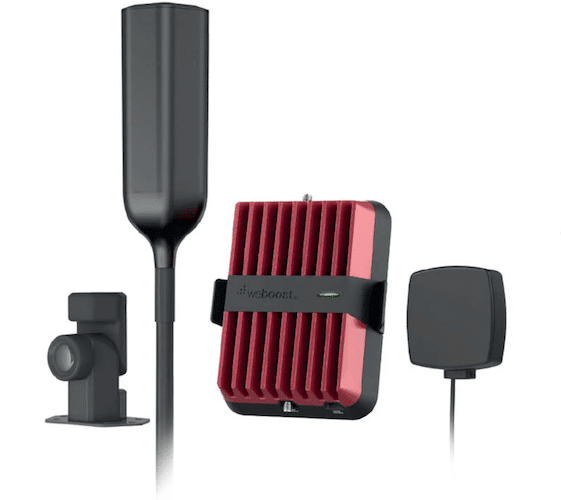
Includes: Signal Booster with bracket, power supply, and hardwire power supply with in-line fuse holder, Inside Antenna, Outside Antenna with 25′ cable, cable entry cover, and heat-shrink tubes, 13″ Mast Extension with side-exit adapter, spring, and thread lock pack, and Overland Mounting Bracket with mounting hardware.
With an IP66 dust and water protection rating, the Drive Reach RV II is a rugged weBoost cell signal booster designed for off-grid camping. It supports multiple devices, works with all major US carriers, and can be hardwired directly into your RV for a permanent installation.
The adjustable mounting bracket allows you to reposition the outside antenna for superior service—you’re only limited by the 25’ cable length. Plus, this cellphone signal booster from weBoost is tested to military standards for shock and vibration resistance, giving you confidence it can handle the bumps of the road in your RV.
WeBoost Drive X Cellular Phone Signal Booster
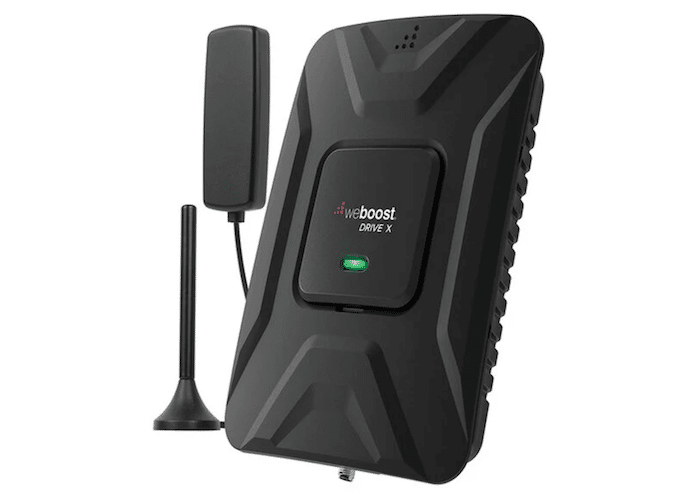
Includes: Booster with mounting bracket, Slim Low-Profile Antenna, 4″ Mini Magnet-Mount Antenna, and Power Supply.
Whether you’re searching for a Verizon cell signal booster or one that supports carriers like AT&T, T-Mobile, and US Cellular, the Drive X delivers multi-carrier compatibility. It’s one of weBoost’s best values because it offers a tool-free installation and can be relocated as needed. It’s as functional at boosting the signal in a stationary RV as it is while you’re on the move inside your tow vehicle.
Once installed, the low-profile antenna won’t be in the way, but you will need a 12V power supply for this cell repeater. That’s what makes it excellent for use in the cab of a truck or a tow-capable SUV. However, powering it with a sufficiently-sized portable battery bank is a realistic alternative for improving cell reception in rural areas without draining your RV or car battery.
Choosing the Best Cell Signal Booster for RV Camping
Use these key criteria to understand what separates a good RV cell signal booster from a great one.
How Much Do They Amplify a Signal?
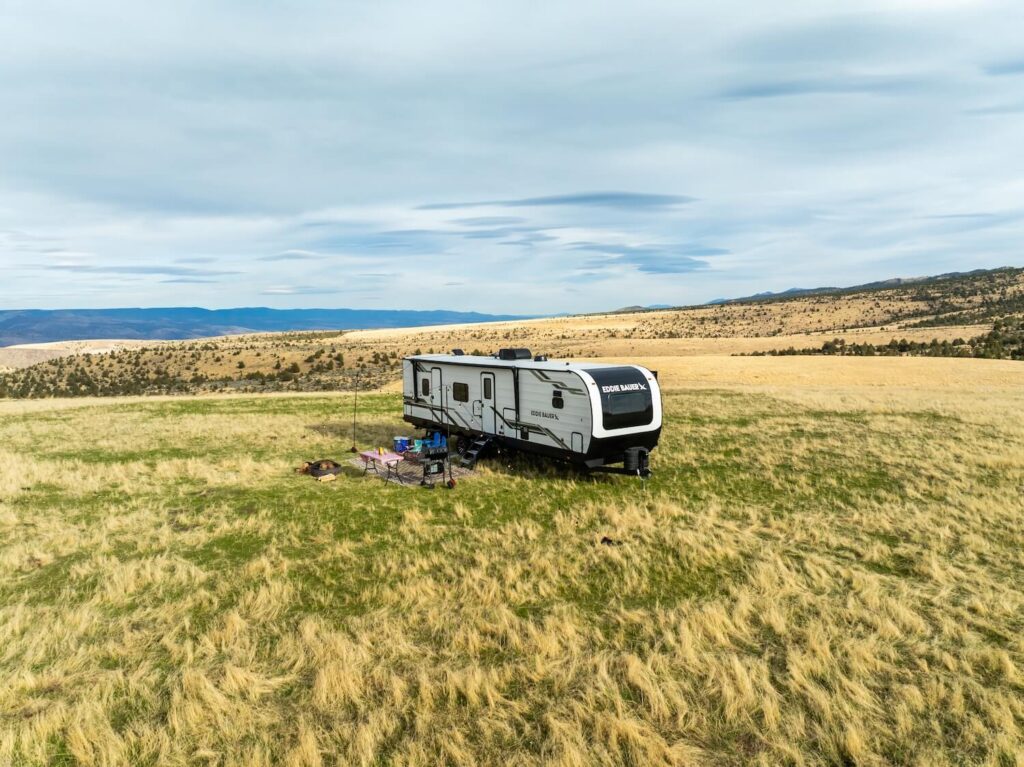
Signal boosters are rated by how much they can amplify weak signals. Most RV models offer up to 32x amplification—the FCC’s legal maximum for consumer use. This amplification can make a significant difference when searching for the best cell signal booster for rural areas where only 1-2 service bars are available.
Pay attention to both the gain (measured in decibels, or dB) and the overall system design to ensure it’s optimized for mobile use. More powerful systems also tend to reach cell towers farther away, giving you a wider range of coverage.
Which Carriers Support Your Booster?
Look for boosters compatible with all major US carriers, including Verizon, AT&T, and T-Mobile. Compatibility is especially important if you switch providers frequently or travel with others who use different carriers. Better yet, choose a top-rated cellphone signal booster for multiple carriers. This ensures everyone in your RV can benefit from improved reception, regardless of their mobile provider.
What Power Do I Need?

Most RV cell signal boosters come with power adapters, allowing you to plug them into an AC or DC outlet, whether plugged into shore power or running off batteries. If you often camp without hookups, ensure your booster can run efficiently on 12V DC or your RV’s battery bank. Some boosters also draw very little power, making them ideal for solar-powered setups or energy-conscious boondockers.
RV Pro Tip: Using a portable power station or RV solar generator to power your cell signal booster will help you keep your RV battery sufficiently charged for other uses.
Do You Need a Portable or Permanent Cell Booster?
Your needs will change depending on where and how you camp. A permanently mounted wireless cell booster might be ideal for full-timers or larger rigs. However, portable options with tripods and carry bags are better for weekend travelers or campers who move often. The ability to easily reposition the antenna allows you to test multiple locations and find the best signal, especially in areas with uneven terrain or dense vegetation.
How Many Devices Can It Support?
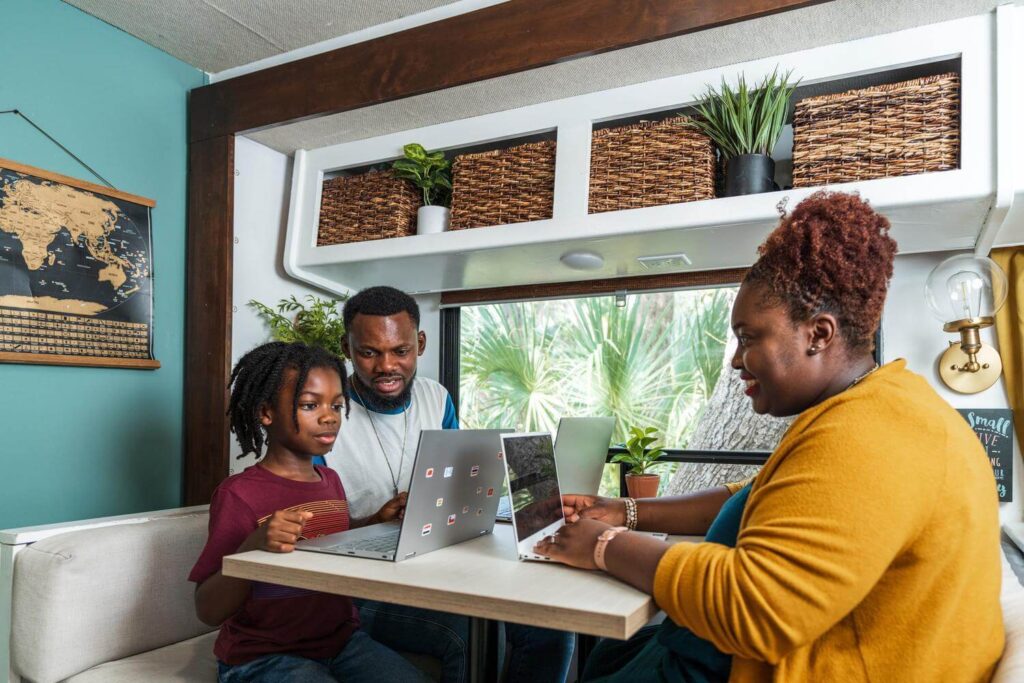
Some cell repeaters are designed for a single device, while others support multiple users simultaneously. Ensure your booster can handle simultaneous connections without degrading performance, especially if you’re traveling with a partner or family—or using several connected devices for work or streaming. Most high-end RV cell boosters will support multiple devices, but it’s always worth verifying.
Use these additional resources to ensure you have the right RV technology to feel safe and connected wherever you camp:
- Is Adding Solar to Your RV Worth It?
- What’s the Best Internet Option for RV Living?
- Off-Grid Camping Essentials Checklist
Do you know which cell signal booster you’ll use for your RV? Let us know in the comments below!
Author
-

Tucker Ballister is our Content Strategist. He grew up RV camping in a Fleetwood Bounder with his parents and has lived and camped in two motorhomes and two travel trailers of his own. His current RV is a 2025 Forest River Campsite Ultra 26BW, which he loves taking on adventures with his wonderful partner and furry companion from their home base in Western North Carolina. Check out his adventures, gear reviews, and outdoor advice at thebackpackguide.com.
View all posts








